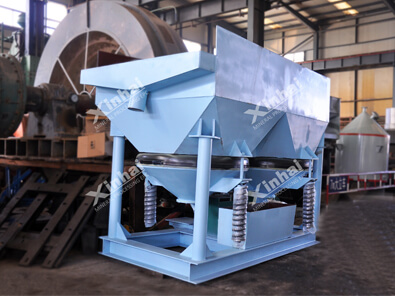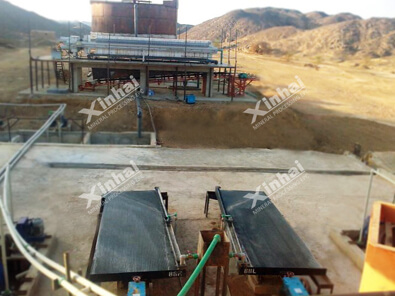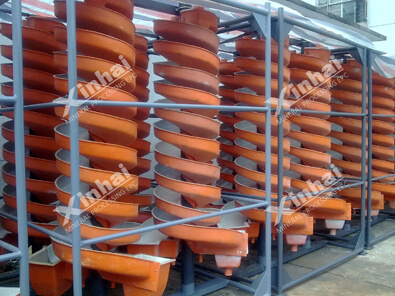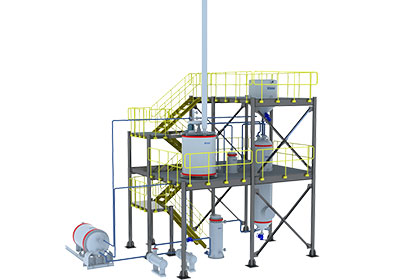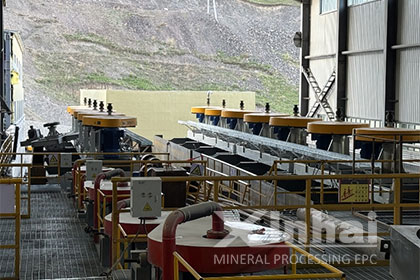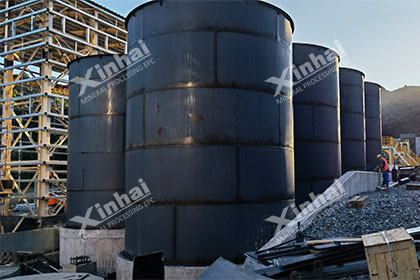Comprehensive Guide to Gravity Separator Maintenance
 Essow
Essow
 Sep 20, 2023
Sep 20, 2023
 3790
3790
If you want to know more details about equipment, solutions, etc, please click the button below for free consultation, or leave your requirements!
Gravity separators are widely used in industries such as mining, recycling, and agriculture to separate materials based on their specific gravity. These machines rely on the force of gravity to separate particles of different densities, making them an essential component of many operations. To ensure the continued efficiency and longevity of gravity separators, regular maintenance is crucial. In this comprehensive guide, we will delve into the importance of gravity separator maintenance and provide practical tips and guidelines for optimal upkeep.
01 Importance of Gravity Separator Maintenance
Back1. Maximizing Efficiency
Efficient operations are vital for industries relying on gravity separators. Regular maintenance ensures that these machines operate at peak efficiency, resulting in enhanced material separation and improved product quality. Properly maintained equipment can achieve higher recovery rates, minimizing material loss and increasing profitability.
2. Preventing Downtime
Unplanned breakdowns can be costly, leading to production delays and increased expenses. Regular maintenance and inspections help identify potential issues before they escalate, preventing unexpected downtime. Addressing maintenance needs proactively reduces the risk of major failures and allows for timely repairs or replacements.
3. Extending Equipment Lifespan
Gravity separators represent significant investments for businesses. Implementing routine maintenance practices, such as lubrication, cleaning, and component inspections, can extend the lifespan of these machines. By reducing wear and tear and addressing minor issues promptly, maintenance helps avoid premature replacements, saving on capital expenses.

(Gravity Separator-Jig)
02 Key Guidelines for Gravity Separator Maintenance
Back1. Establish a Maintenance Schedule
Establishing a maintenance schedule for gravity separators is crucial to ensure regular upkeep and optimal performance. Here are some steps to help you create an effective maintenance schedule:
Review Manufacturer Guidelines
Begin by reviewing the manufacturer's guidelines and recommendations for maintenance. The manufacturer usually provides a maintenance manual or documentation specific to the gravity separator model you are using. Familiarize yourself with the recommended maintenance tasks, intervals, and procedures suggested by the manufacturer.
Identify Critical Maintenance Tasks
Based on the manufacturer's recommendations and your equipment's specific requirements, identify the critical maintenance tasks that need to be performed regularly. These tasks may include visual inspections, lubrication, cleaning, calibration, and component maintenance, as mentioned earlier in the article.
Determine Frequency
Determine the frequency at which each maintenance task needs to be performed. Some tasks may need to be conducted daily, while others can be scheduled weekly, monthly, or annually. The frequency will depend on factors such as the operating conditions, equipment usage, and the manufacturer's guidelines.
Prioritize Tasks
Prioritize the maintenance tasks based on their importance and impact on the performance and longevity of the gravity separator. Tasks that directly affect safety, efficiency, or critical components should be given higher priority. Ensure that essential tasks are included in the schedule and receive sufficient attention.
Consider Operational Factors
Take into account operational factors when scheduling maintenance tasks. Avoid scheduling maintenance during peak production times to minimize disruptions. Consider seasonal or operational cycles that may affect the frequency or timing of specific tasks. Plan maintenance activities accordingly to ensure minimal interference with production schedules.
Assign Responsibility
Clearly assign responsibility for each maintenance task. Identify the individuals or teams responsible for conducting specific tasks and ensure they have the necessary training and expertise. Assigning responsibility helps ensure accountability and streamlines the maintenance process.
Document the Schedule
Document the maintenance schedule in a clear and organized manner. Use a spreadsheet, maintenance management software, or any other tool that is convenient for you. Include the task, frequency, responsible party, and any additional notes or instructions. Make sure the schedule is easily accessible to everyone involved in the maintenance process.
Review and Update
Regularly review and update the maintenance schedule as needed. Monitor the effectiveness of the schedule and make adjustments based on observations, equipment performance, and any changes in operational requirements. Continuously improve the schedule to optimize maintenance efforts and adapt to evolving needs.
Remember that the maintenance schedule should be a living document and subject to revision as necessary. Regularly communicate and collaborate with operators and maintenance personnel to ensure the schedule is realistic, effective, and aligned with the overall operational objectives.
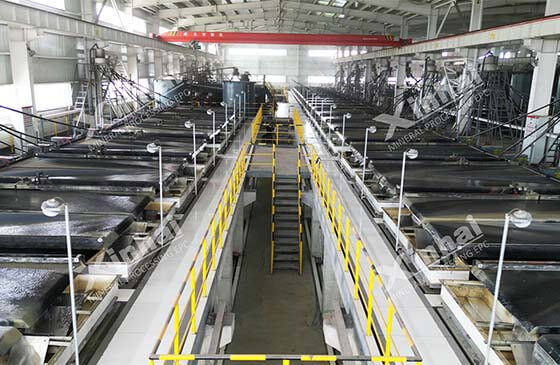
(Gravity Separator-Shaking Table)
2. Visual Inspections
Visual inspection is an essential maintenance task for gravity separators as it helps identify potential issues and detect any visible signs of wear, damage, or abnormalities. Here's a step-by-step guide on how to conduct a visual inspection:
Prepare for Inspection
Ensure the gravity separator is turned off and disconnected from the power source.
Put on appropriate personal protective equipment (PPE) such as safety glasses, gloves, and any other necessary protective gear.
Start with a Clean Surface
Remove any dirt, dust, or debris from the exterior of the gravity separator using a soft brush, cloth, or compressed air.
Clean the areas around critical components such as belts, pulleys, bearings, screens, sieves, and electrical connections to ensure a clear view during inspection.
Systematically Inspect Components
Begin inspecting the gravity separator from one end to the other, systematically examining each component.
Look for signs of wear, damage, misalignment, or any visible abnormalities. Pay attention to the following components:
Belts: Check for signs of wear, cracks, or misalignment. Ensure proper tension and alignment.
Pulleys: Inspect pulleys for any damage, wear, or misalignment. Verify that they rotate smoothly.
Bearings: Examine bearings for signs of wear, corrosion, or damage. Look for any unusual noises or vibrations.
Screens, Sieves, and Decks: Inspect these components for tears, clogs, or excessive wear. Check for proper installation and alignment.
Electrical Components: Look for loose connections, damaged wires, or signs of overheating. Inspect control panels for any issues.
Safety Guards and Interlocks: Ensure all safety guards, covers, and interlocks are in place and functioning correctly.
Document Findings
Take notes or use a checklist to document any observations or abnormalities detected during the inspection.
Record the location, description of the issue, and any recommended actions for further investigation or repairs.
Address Immediate Concerns
If any critical issues or safety hazards are identified during the visual inspection, take immediate action to address them. This may involve stopping the equipment and consulting experts or maintenance personnel for appropriate measures.
Follow Up with Maintenance Tasks
Based on the findings from the visual inspection, schedule and prioritize the necessary maintenance tasks, such as lubrication, cleaning, or component replacements.
Ensure that identified issues are addressed promptly to prevent further damage or potential failures.
Regularly Repeat Visual Inspections
Perform visual inspections at regular intervals as part of the overall maintenance schedule.
Follow the recommended frequency provided by the manufacturer or adjust it based on the equipment's usage and operating conditions.
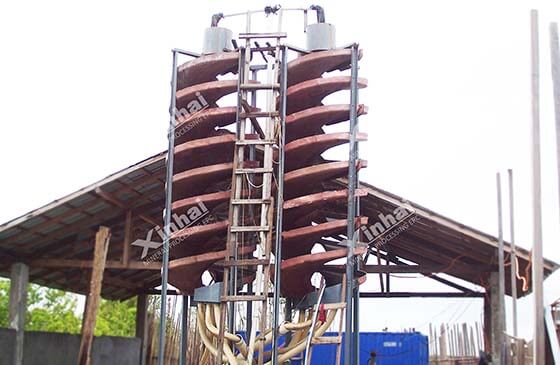
(Gravity Separator-Spiral Chute)
3. Lubrication
Lubrication plays a vital role in maintaining the smooth operation of gravity separators. Follow the manufacturer's guidelines for lubrication intervals and use recommended lubricants. Lubricate bearings, gears, and other moving parts to minimize friction and prevent premature wear. Regularly check lubricant levels and replenish or replace as necessary.
4. Cleaning and Debris Removal
Regular cleaning is necessary to remove accumulated dirt, dust, and debris from gravity separators. Clean the machine thoroughly, paying attention to all components and areas prone to buildup. Ensure that screens, sieves, and meshes are clean and free from material clogging. Clear any blockages in material flow paths, chutes, and discharge points.
5. Calibration and Adjustment
Periodically calibrate the gravity separation system to maintain accurate and consistent performance. Follow the manufacturer's guidelines for calibration procedures. Adjust the settings and parameters as required to optimize separation efficiency. Monitor and adjust the feed rate, tilt angle, and water flow to ensure optimal operating conditions.
6. Component Maintenance
Pay close attention to specific components of gravity separators:
Belts and Pulleys: Check for proper alignment, tension, and wear. Replace worn or damaged belts promptly.
Bearings: Inspect bearings for signs of wear or damage. Lubricate as recommended and replace faulty bearings.
Screens, Sieves, and Decks: Regularly inspect for tears, clogs, or excessive wear. Replace damaged components as needed.
Electrical Components: Inspect wiring, connections, and control panels for any issues. Address electrical problems promptly or consult an expert if needed.
7. Safety Measures
Safety should be a top priority during gravity separator maintenance. Ensure that all safety guards, covers, and interlocks are in place and functioning correctly. Train operators on safe maintenance practices and provide them with appropriate personal protective equipment (PPE).
8. Documentation and Record-Keeping
Maintain detailed records of maintenance activities, including inspections, repairs, and replacements. Document calibration settings and adjustments made during maintenance. Keep a log of performance indicators, such as recovery rates, to track the effectiveness of maintenance efforts. This information helps identify trends and facilitates future maintenance planning.
03 Training and Team Collaboration
BackInvest in training programs to educate operators and maintenance personnel on the proper use, maintenance, and troubleshooting of gravity separators. Encourage teamwork and collaboration between operators and maintenance staff to enhance communication and ensure the smooth operation of the equipment.
Training and team collaboration for gravity separator maintenance are crucial for ensuring effective upkeep and optimal performance. Here's a guide on how to implement training and foster collaboration specifically for gravity separator maintenance:
1. Identify Maintenance Needs
Assess the specific maintenance requirements of gravity separators used in your organization.
Identify the key skills and knowledge areas needed for effective maintenance.
2. Develop a Training Plan
Outline the training objectives, topics, and methods specific to gravity separator maintenance.
Include technical aspects such as equipment operation, troubleshooting, inspection techniques, and safety protocols.
3. Provide Hands-on Training
Arrange practical training sessions that allow maintenance personnel to work directly with gravity separators.
Provide guidance on proper maintenance procedures, component replacements, and calibration techniques.
4. Partner with Manufacturers or Experts
Collaborate with gravity separator manufacturers or industry experts to conduct specialized training programs.
Utilize their expertise to train maintenance teams on specific equipment models and best practices.
5. Document Standard Operating Procedures (SOPs)
Develop clear and comprehensive SOPs for gravity separator maintenance tasks.
Include step-by-step instructions, safety guidelines, and recommended schedules for routine maintenance.
6. Foster Collaboration within the Maintenance Team
Encourage regular communication and knowledge sharing among maintenance team members.
Organize team meetings, brainstorming sessions, or workshops to facilitate collaboration and problem-solving.
7. Cross-Train Team Members
Encourage cross-training among maintenance personnel to broaden their skill sets.
Ensure that team members have a basic understanding of all critical maintenance tasks to promote flexibility and teamwork.
8. Establish a Feedback Loop
Encourage maintenance personnel to provide feedback on maintenance procedures, equipment performance, and training effectiveness.
Use this feedback to continuously improve training programs and maintenance processes.
9. Conduct Regular Refresher Training
Schedule periodic refresher training sessions to reinforce key concepts and address any updates or changes in equipment or procedures.
Stay updated with new advancements or technologies in gravity separator maintenance and incorporate them into training programs.
10. Recognize and Reward Collaboration and Performance
Acknowledge and reward individuals and teams that demonstrate exceptional collaboration and maintenance performance.
Create a culture that values teamwork, continuous learning, and excellence in gravity separator maintenance.
04Conclusion
BackGravity separator maintenance is essential for achieving optimal performance and prolonging the lifespan of these critical machines. By following the guidelines outlined in this article, industries can maximize efficiency, prevent downtime, and extend the longevity of their gravity separators. Regular inspections, lubrication, cleaning, calibration, and component maintenance are key aspects of an effective gravity separator maintenance program. Remember to prioritize safety and keep detailed records of maintenance activities. By implementing these practices, businesses can ensure the continued efficiency and reliability of their gravity separation operations, leading to improved productivity and cost savings in the long run.
We have articles about maintenance of all kinds of equipment, please click the titles to check them.
Maximizing Ball Mill Performance: A Comprehensive Guide to Effective Maintenance
Comprehensive Guide to Flotation Machine Maintenance
 +86 183 3575 8886
+86 183 3575 8886 pinklaurabao@gmail.com
pinklaurabao@gmail.com




 Message
Message Chat Now
Chat Now


